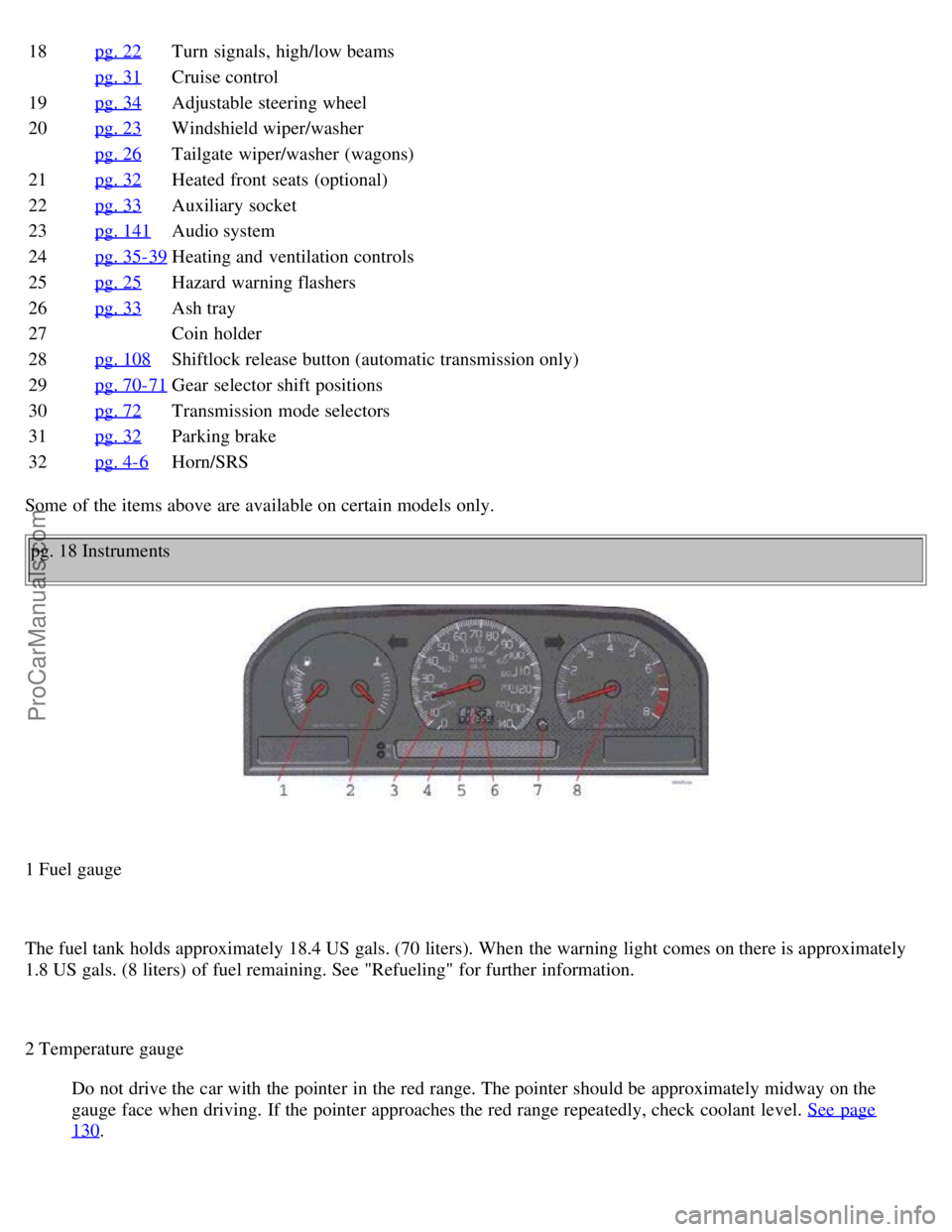warning light VOLVO S70 1998 Owners Manual
[x] Cancel search | Manufacturer: VOLVO, Model Year: 1998, Model line: S70, Model: VOLVO S70 1998Pages: 52, PDF Size: 0.89 MB
Page 10 of 52

18pg. 22Turn signals, high/low beams
pg. 31Cruise control
19 pg. 34
Adjustable steering wheel
20 pg. 23
Windshield wiper/washer
pg. 26
Tailgate wiper/washer (wagons)
21 pg. 32
Heated front seats (optional)
22 pg. 33
Auxiliary socket
23 pg. 141
Audio system
24 pg. 35-39
Heating and ventilation controls
25 pg. 25
Hazard warning flashers
26 pg. 33
Ash tray
27 Coin holder
28 pg. 108
Shiftlock release button (automatic transmission only)
29 pg. 70-71
Gear selector shift positions
30 pg. 72
Transmission mode selectors
31 pg. 32
Parking brake
32 pg. 4-6
Horn/SRS
Some of the items above are available on certain models only.
pg. 18 Instruments
1 Fuel gauge
The fuel tank holds approximately 18.4 US gals. (70 liters). When the warning light comes on there is approximately
1.8 US gals. (8 liters) of fuel remaining. See "Refueling" for further information.
2 Temperature gauge Do not drive the car with the pointer in the red range. The pointer should be approximately midway on the
gauge face when driving. If the pointer approaches the red range repeatedly, check coolant level. See page
130.
ProCarManuals.com
Page 20 of 52

accommodate possible expansion of the fuel in hot weather. Be aware that the "usable" tank will be somewhat less than
the specified maximum. When the fuel level is low, such factors as ambient temperature, the fuel's "vapor pressure"
characteristics, and terrain can affect the fuel pumps' ability to supply the engine with an adequate supply of fuel.
Therefore, it is advisable to refuel as soon as possible when the needle nears the red zone, or when the fuel warning
light comes on.CAUTION:
Do not refuel with the engine running. After refueling, close the fuel filler cap by turning it clockwise until it
clicks into place.
Allow for fuel expansion by not overfilling the tank. Overfilling could also cause damage to the emission control
systems.
NOTE: If the fuel filler cap is not closed tightly or if the engine is running when the car is refueled, the Malfunction
Indicator Lamp may indicate a fault. Use only Volvo original or approved fuel filler caps. CAUTION: Avoid spilling gasoline during refueling. Gasolines containing alcohol can cause damage to painted
surfaces, which may not be covered under the New Vehicle Limited Warranty.
Do not use gasoline containing methanol (methyl alcohol, wood alcohol). This practice can result in vehicle
performance deterioration and can damage critical parts in the fuel system. Such damage may not be covered under
the New Vehicle LimitedWarranty.
pg. 68 Driving economy
Economical driving conserves natural resources
Better driving economy may be obtained by thinking ahead, avoiding rapid starts and stops and adjusting the speed of
your vehicle to immediate traffic conditions. Observe the following rules:
Bring the engine to normal operating temperature as soon as possible by driving with a light foot on the accelerator
pedal for the first few minutes of operation. A cold engine uses more fuel and is subject to increased wear.
Whenever possible, avoid using the car for driving short distances. This does not allow the engine to reach normal
operating temperature.
Drive carefully and avoid rapid acceleration and hard braking.
Do not exceed speed limit.
Avoid carrying unnecessary items (extra load) in the car.
Check tire pressure regularly (check when tires are cold).
Remove snow tires when threat of snow or ice has ended.
Note that roof racks, ski racks, etc., increase air resistance and thereby fuel consumption.
Avoid using automatic transmission kick-down feature unless necessary.
Avoid using the air conditioning when it is not required. When engaged, the air conditioner's compressor places an
additional load on the engine. However, please note that fuel consumption is lower with the air conditioning on than it
is when driving with the air conditioning switched off and the windows down.
If your car is equipped with the optional Trip Computer, utilizing the fuel consumption modes can help you "learn"
how to drive more economically.
ProCarManuals.com
Page 29 of 52

Attaching the jack on cars with All Wheel Drive (AWD)
Due to the greater weight of AWD-equipped cars, these models have an additional jack attachment point, located
directly in front of the rear axle. When using a workshop floor jack, make sure that the correct attachment is used and
that the jack does not damage the fuel tank.
The attachment is, of course, also intended for use with the standard jack supplied with the car.
Installing the wheel
Clean the contact surfaces on the wheel and hub. Lift the wheel and place it on the hub. Make sure that you align the
wheel with the guide stud on the wheel hub prior to installation. Install the wheel bolts crosswise (see illustration) and
tighten by turning lightly clockwise. Lower the vehicle to the ground and alternately tighten the nuts to 81 ft. lbs. (110
Nm). Install the wheel cap (where applicable).
Correct tightening order for wheel bolts
WARNING!
The jack's attachment must engage the bar in the jack attachment (A). The car's weight must not rest on the jack's
attachment (B).
Be sure the jack is on a firm, level, non-slippery surface.
Never allow any part of your body to be extended under a car supported by a jack.
Use the jack intended for the car when replacing a wheel. For any other job, use stands to support the end of the
car being worked on.
Apply the parking brake, select position P (automatic transmission) or Reverse gear (manual transmission).
Block the wheels standing on the ground, use rigid wooden blocks or large stones.
The jack should be kept well-greased.
pg. 94 Spare tire
ProCarManuals.com